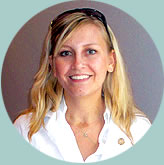
Pascal J. Goldschmidt, M.D., will raise medical school to new level
New Dean Named for Miller School of Medicine
![]() ascal
J. Goldschmidt, M.D., an internationally renowned cardiologist and
chairman of the Department of Medicine at Duke University Medical Center,
has been named senior vice president for medical affairs and dean of
the University of Miami Leonard M. Miller School of Medicine.
ascal
J. Goldschmidt, M.D., an internationally renowned cardiologist and
chairman of the Department of Medicine at Duke University Medical Center,
has been named senior vice president for medical affairs and dean of
the University of Miami Leonard M. Miller School of Medicine.
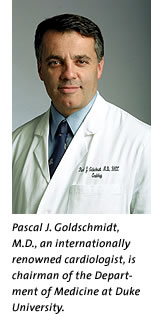 “I think Dr. Goldschmidt is a perfect match for the University
of Miami,” University
President Donna E. Shalala said in a February 3 announcement. “He’s
a first-rate leader and a wonderful researcher-clinician who will raise
the Miller School to a spectacular new level of international medical
and scientific leadership.”
“I think Dr. Goldschmidt is a perfect match for the University
of Miami,” University
President Donna E. Shalala said in a February 3 announcement. “He’s
a first-rate leader and a wonderful researcher-clinician who will raise
the Miller School to a spectacular new level of international medical
and scientific leadership.”
Goldschmidt, whose research applies genomics and cell therapy to the prevention, diagnosis, and treatment of coronary artery disease, was previously chief of the Division of Cardiology at Duke. Before joining the Duke faculty in 2000, he was director of cardiology at The Ohio State University College of Medicine and Public Health, where he built the Heart and Lung Research Institute and a heart hospital.
As chairman of Duke’s Department of Medicine, the largest department at the university, Goldschmidt oversees a $250 million enterprise with 350 full-time physician faculty members, 80 Ph.D.’s, 1,200 staff, and 300 trainees in 16 divisions. Groundbreaking clinical and laboratory research is a major focus, with clinical services based at Duke University Hospital.

During Goldschmidt’s tenure as chief of Duke’s cardiology division and chairman of the Department of Medicine, research funding from the National Institutes of Health more than doubled and now ranks in the top three nationally.
At Ohio State he founded the Heart and Lung Institute, a freestanding facility with 30 principal investigators and more than 120 scientists devoted to research of diseases affecting the heart, lungs, and blood vessels.
Goldschmidt, who begins his post April 3, arrives at a time of tremendous growth at the Miller School of Medicine.
“I am incredibly delighted to be welcomed to the University of Miami,” said Goldschmidt. “The Miller School of Medicine has an international reputation for excellence, and I plan to work with my teams to bring the clinical mission, the research mission, and the educational mission to new heights. I also feel honored and humbled to succeed John Clarkson at the helm, a remarkable leader whose career has been exemplary.
“I look forward to cultivating our unique relationship with Jackson Memorial Hospital and its leadership to expand our ability to deliver outstanding care to the great people of Miami-Dade, and to train the doctors who will lead the medical field for years to come.”
“This is a great day for the University,” said Norman Braman, chairman of the Medical Affairs Committee of the University of Miami Board of Trustees. “To be able to get an individual of Dr. Goldschmidt’s caliber says a lot for the University’s commitment to make our medical school one of the great schools in the United States. It shows great confidence in everything President Shalala and Dean Clarkson have been working toward all these years.”
A native of Belgium, Goldschmidt received his medical degree from the Universite Libre de Bruxelles and completed residency and fellowship training in Brussels at Erasme Academic Hospital and in the United States at Johns Hopkins University.
The new dean said he and his wife and three young children “look forward to calling the city of Miami and its great university home.
See the next issue of Miami Medicine for an in-depth interview with Dean Goldschmidt.
Inhaled Insulin Effective in Type 1 Diabetes
It’s estimated that of the 18 million Americans who have diabetes, more than one million are diagnosed with the autoimmune form of the disease, or type 1 diabetes. The inhaled insulin used in the study, Exubera, was approved for public use by the Food and Drug Administration in January. It is manufactured and marketed by Pfizer Inc. |
Developing a Multidisciplinary Curriculum on Research Conduct
Building a CITI
![]() n
2000, then-U.S. Secretary of Health and Human Services Donna E. Shalala
announced a new policy aimed at improving and tightening the orchestration
of all research projects. One of the initiatives required specialized
training for all individuals engaged in human subjects research. The
policy was announced in June and scheduled to be implemented in October.
That gave universities and research institutions four months to get their
programs in place.
n
2000, then-U.S. Secretary of Health and Human Services Donna E. Shalala
announced a new policy aimed at improving and tightening the orchestration
of all research projects. One of the initiatives required specialized
training for all individuals engaged in human subjects research. The
policy was announced in June and scheduled to be implemented in October.
That gave universities and research institutions four months to get their
programs in place.
Fortunately for the University of Miami, a faculty member had been working on such a program even before the policy was announced.
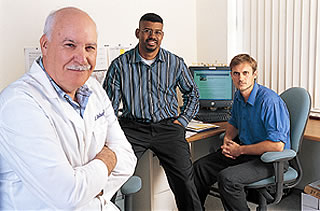 |
||
 |
Paul Braunschweiger, Ph.D., a professor of radiation oncology and chair of the animal care and use committee, had already begun a collaboration with Karen Hansen at the Fred Hutchinson Cancer Research Center to develop an online training program for human subjects protection. “But the announcement provided a much more immediate need to get started, so we contacted ten colleagues from around the country and developed a program called the Collaborative Institutional Training Initiative, or CITI,” Braunschweiger says.
Five years, six iterations, 535 participating institutions, and 300,000 registrants later, Braunschweiger is still working with CITI. But this year, the Office of Research Integrity is expanding the concept and has contracted Braunschweiger and Kenneth Goodman, Ph.D., associate professor of medicine and philosophy and director of UM’s Bioethics Program, to create a multidisciplinary responsible conduct in research (RCR) curriculum modeled on the CITI program.
“The concern is what is good practice in one discipline may not be good practice in another,” Braunschweiger says.
Faculty would sign up for the program and use it as an adjunct to what is taught in the classroom. “Let’s say I’m teaching a class called Physics 403, and I want my students to understand the issues regarding responsible conduct of research,” Braunschweiger explains. “I don’t have the resources and materials at my fingertips to be able to devise numerous lectures on these sort of topics. Knowing that the University has this resource available, I’m going to design an online curriculum in the CITI program that my students can take. And then I may spend time in class discussing the topics in more detail.”
The LifeSaving Efforts of a Miller School Team
Fixing Miss Florida
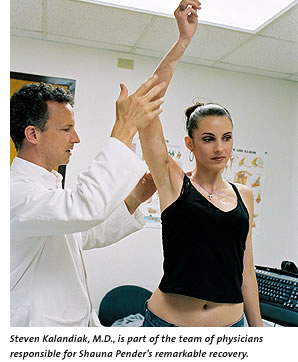
![]() hauna
Pender had everything going for her. Then she got hit by a truck. A three-time
first runner-up in the Miss Florida pageant, Shauna was finally crowned
Miss Florida in October 2003. Two weeks later, on her way to her first
official appearance, an 18-wheeler lost control and fell on top of her
car.
hauna
Pender had everything going for her. Then she got hit by a truck. A three-time
first runner-up in the Miss Florida pageant, Shauna was finally crowned
Miss Florida in October 2003. Two weeks later, on her way to her first
official appearance, an 18-wheeler lost control and fell on top of her
car.
Her extensive injuries were life threatening, says Steven Kalandiak, M.D., assistant professor of clinical orthopaedics in the Department of Orthopaedics and Rehabilitation. “In addition to a traumatic brain injury and an aortic tear that nearly took her life, she had her chest and right arm torn open from the left shoulder across her chest and halfway down to her right elbow. Her shoulder muscle was ripped off her collarbone and her chest muscle was torn off of its attachment to her arm. She broke every bone in her right arm from her breastbone to her wrist, some in more than one place. Basically, the only things still attaching her arm to her body were its artery and nerves and some of the muscles around her shoulder blade.”
A team of Miller School of Medicine physicians immediately went to work, saving Shauna’s life and repairing the extensive trauma. Over six weeks, she underwent six surgeries. Although she can’t even name all the injuries she suffered, she can say what saved her—her UM physicians. “They put me back together again.”
Two months after the accident, Shauna left the hospital. Two years later, she is pursuing a career as an inspirational/motivational speaker who talks about living life to the fullest. And she always reserves the highest praise for her favorite University of Miami doctors.
“They were so amazing,” she says, and notes that if she had any good luck that day, it was that the accident happened just a few miles from the Ryder Trauma Center, where she was able to receive treatment from some of the best surgeons in the country. “If my accident had happened anywhere else, I would be dead.”
“Her recovery has been remarkable,” says Kalandiak. “I’m embarrassed to admit that I expected Miss Florida to be a ‘high maintenance’ patient, but she has proven to be one of the toughest, bravest, and hardest-working young women I’ve treated. She healed completely, recovered her cognitive function, and regained almost full use of her mangled right arm. It’s really an amazing story.”
Transplant Program Marks a Milestone
Multivisceral transplantation is a simultaneous transplantation of the abdominal organs—the stomach, pancreas, spleen, and the intestines, frequently with the liver, kidneys, and abdominal wall. The team recently published its experience with 100 multivisceral transplants in the Annals of Surgery. A ten-year review showed that advanced surgical techniques, improved monitoring, and better immunosuppression have greatly improved the results of these transplants. “This is a transplant that has come of age for patients who would otherwise have no hope of survival,” says Andreas Tzakis, M.D., Ph.D., director of the Division of Liver and GI Transplantation at the Miller School of Medicine. |
Seen and Heard across the nation
 |
||
Making Headlines
Comments on a Stormy Season
The unprecedented devastation of two back-to-back major hurricanes kept faculty members busy providing expert interviews with the media. The Miami Herald did several stories with Richard Weisman, Pharm.D., and Joseph Scott, M.D., who were both deployed as part of FEMA’s Florida 5 disaster medical assistance team. Patricia Cantwell, M.D., and David Shatz, M.D., were also deployed by their respective disaster medical assistance teams. Before leaving, Cantwell participated in a story on the hurricane disaster on WebMD.
Infectious disease specialist Charles Mitchell, M.D., was interviewed by the Sun-Sentinel about the possible risk of disease in the New Orleans floodwaters, and the story was picked up by 16 other newspapers. He also appeared on FOX News Channel. Delia Rivera, M.D., was interviewed on the same subject by The Miami Herald, and the story was picked up by 17 newspapers.
The emotional fallout from the hurricanes was another big topic for the media. Mercedes Briones, M.D., appeared on CNN en Español to talk about the impact on children; Jon Shaw, M.D., and Eva Ritvo, M.D., were interviewed by WebMD for stories about mental health issues after the hurricanes.
More Worldwide Headlines on Six-Organ Transplant
A 19-month-old Japanese boy, Yosuke Ohashi, who underwent a six-organ transplant at Jackson Memorial Hospital, was the subject of stories worldwide when he returned home to Japan in September. The toddler had surgery on Christmas Eve 2004, a lifesaving operation that could not be performed in Japan because donated organs are not available there for young children. Tomoaki Kato, M.D., associate professor of surgery, headed the transplant team. The story was covered by every television station in Miami and 13 additional stations across the country, and by The Miami Herald, the Sun-Sentinel, 94 other newspapers nationwide, 48 Web sites, eight radio stations, and 23 international media outlets.
Ensuring Defibrillator Safety
The appointment of Robert Myerburg, M.D., professor of medicine and physiology, as chairman of a safety panel put together by the Guidant Corporation made headlines across the country at the end of August. Earlier in the summer Guidant recalled 109,000 defibrillators, but quickly came under fire for the way physicians and patients were notified. The company then took the unusual step of appointing a 12-member panel to review its handling of the recall and to make recommendations on how to do it better. The story appeared in The New York Times, Daily Business News, The Miami Herald, and 14 other publications nationwide.
Back to top
 |
||||
 |
||||
 |
||||
 |
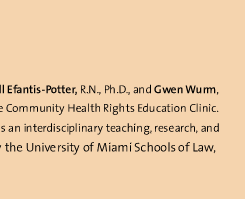 |
|||
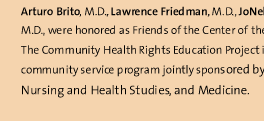 |
||||
Photo by John Zillioux (Braunschweiger), and Donna Victor (Kalandiak) and Reuters/Associated Press (Flood)
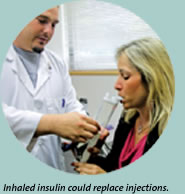 In
a discovery with the potential to dramatically improve quality
of life for people
with diabetes, Jay Skyler, M.D., professor of
medicine, has found that inhaled insulin works just as well at
controlling blood sugar levels as injected insulin. “This research shows
that inhaled insulin before meals works exactly the same as injected
insulin before meals, even in people who do not make any insulin
on their own,” said Skyler, lead investigator and author
of the study, which appeared in the journal Diabetes Care.
In
a discovery with the potential to dramatically improve quality
of life for people
with diabetes, Jay Skyler, M.D., professor of
medicine, has found that inhaled insulin works just as well at
controlling blood sugar levels as injected insulin. “This research shows
that inhaled insulin before meals works exactly the same as injected
insulin before meals, even in people who do not make any insulin
on their own,” said Skyler, lead investigator and author
of the study, which appeared in the journal Diabetes Care. 